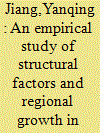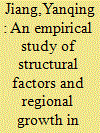| Srl | Item |
| 1 |
ID:
099774


|
|
|
|
|
| Publication |
2010,
|
| Summary/Abstract |
Based on data of 31 Chinese provinces over the period 1980-2004, the study in this paper presents new evidence on the effects of structural shocks and structural transformation on growth and convergence among the Chinese regions. The division of overall regional growth in labour productivity into three components - growth due to structural shocks, growth due to structural transformation and a 'residual' indicating growth due to region-specific changes - provides us with a better framework than the traditional one-sector Solow growth model for attributing growth and convergence to various different sources. Among other findings, the study has shown that during 1990-1999, structural shocks worked to widen the gap between rich regions and poor regions in China, while structural transformation worked to narrow the gap.
|
|
|
|
|
|
|
|
|
|
|
|
|
|
|
|
| 2 |
ID:
099773


|
|
|
|
|
| Summary/Abstract |
Based on data of 31 Chinese provinces over the period 1980-2004, the study in this paper presents new evidence on the effects of structural shocks and structural transformation on growth and convergence among the Chinese regions. The division of overall regional growth in labour productivity into three components - growth due to structural shocks, growth due to structural transformation and a 'residual' indicating growth due to region-specific changes - provides us with a better framework than the traditional one-sector Solow growth model for attributing growth and convergence to various different sources. Among other findings, the study has shown that during 1990-1999, structural shocks worked to widen the gap between rich regions and poor regions in China, while structural transformation worked to narrow the gap.
|
|
|
|
|
|
|
|
|
|
|
|
|
|
|
|
| 3 |
ID:
136062


|
|
|
|
|
| Summary/Abstract |
An open border, a pegged exchange rate regime and large trade with India offer Nepal some preconditions to satisfy monetary integration with its southern neighbour. In this study, investigation of the economic symmetry in the two countries is considered. A two-pronged empirical approach reveals inconclusive evidence to satisfy such integration. First, using a three-variable structural vector auto-regression showed a low and negative correlation in the supply shocks. Decomposing the structural shocks into regional and idiosyncratic components showed a favourable co-movement with the regional element only in Nepal’s monetary shock. Second, the business-cycle analysis using state-space models of Nepal’s GDP and its components showed evidence of co-movement with the regional element in some variables while others showed divergence.
|
|
|
|
|
|
|
|
|
|
|
|
|
|
|
|
| 4 |
ID:
115683


|
|
|
|
|
| Publication |
2012.
|
| Summary/Abstract |
Great attention has been paid to the origin of observed wild price fluctuations of solar PV Si feedstock in both contract and spot markets during 2004-2009. This paper sheds light on this issue and tries to resolve it by addressing the following questions: what kind of structural shock is underlying the price fluctuations of PV Si feedstock? How can we quantify the magnitude, timing and relative importance of these shocks? What are their dynamic effects on the real price of PV Si feedstock? By carefully studying development conditions, the structural decomposition of the real price of PV Si feedstock is proposed: exchange rate shocks, production cost shocks, aggregate demand shocks and demand shocks specific to feedstock markets. With a Structural Vector Autoregression model, the paper quantifies and verifies the impact of structural shocks on PV Si feedstock real price changes. Based on national data, an analysis is further taken to confirm the essential role of demand shocks specific to feedstock markets in determining sharper price fluctuations during 2004-2009. The results of this study have important implications for national solar PV development, which can be better promoted and administrated if structural shocks in feedstock markets can be carefully evaluated and understood.
|
|
|
|
|
|
|
|
|
|
|
|
|
|
|
|
| 5 |
ID:
115686


|
|
|
|
|
| Publication |
2012.
|
| Summary/Abstract |
Great attention has been paid to the origin of observed wild price fluctuations of solar PV Si feedstock in both contract and spot markets during 2004-2009. This paper sheds light on this issue and tries to resolve it by addressing the following questions: what kind of structural shock is underlying the price fluctuations of PV Si feedstock? How can we quantify the magnitude, timing and relative importance of these shocks? What are their dynamic effects on the real price of PV Si feedstock? By carefully studying development conditions, the structural decomposition of the real price of PV Si feedstock is proposed: exchange rate shocks, production cost shocks, aggregate demand shocks and demand shocks specific to feedstock markets. With a Structural Vector Autoregression model, the paper quantifies and verifies the impact of structural shocks on PV Si feedstock real price changes. Based on national data, an analysis is further taken to confirm the essential role of demand shocks specific to feedstock markets in determining sharper price fluctuations during 2004-2009. The results of this study have important implications for national solar PV development, which can be better promoted and administrated if structural shocks in feedstock markets can be carefully evaluated and understood.
|
|
|
|
|
|
|
|
|
|
|
|
|
|
|
|